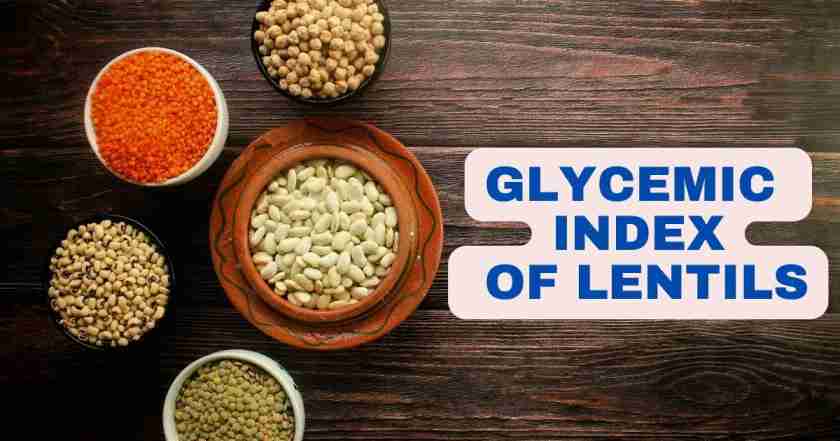What is Glycemic Index (GI)?
The glycemic index (GI) is a measure that ranks how quickly and how much a particular food raises blood sugar levels after consumption. It is a valuable tool for individuals, particularly those with diabetes, as well as those seeking to manage their blood sugar levels and overall health.
Glycemic Index Lentils
Lentils are a type of legume that has been consumed for thousands of years and is known for its nutritional value. They come in various colors, including green, brown, red, and black. Lentils are not only a staple food in many cultures but also a popular choice among vegetarians and vegans due to their high protein content and nutrient density.
When considering the glycemic index, lentils have a low ranking. The GI scale ranges from 0 to 100, with pure glucose having a value of 100, representing the fastest and highest rise in blood sugar levels. Foods with a low GI (below 55) are digested and absorbed more slowly, leading to a gradual and steady release of glucose into the bloodstream.
GI Index of Lentils
What is the Glycemic Index (GI) of Lentils?
- The exact GI value of lentils can vary depending on the type and variety. Generally, lentils have a GI ranging from 18 to 34, making them an excellent choice for individuals aiming to maintain stable blood sugar levels.
- The low GI of lentils is attributed to their high fiber and resistant starch content, both of which contribute to the slower digestion and absorption of carbohydrates.
Fiber plays a crucial role in regulating blood sugar levels. It slows down the digestion process and prevents rapid spikes in glucose levels. Lentils are rich in dietary fiber, with an average serving providing approximately 15 grams of fiber. This high fiber content contributes to the low glycemic index of lentils.
In addition to fiber, lentils also contain resistant starch. Resistant starch is a type of starch that resists digestion in the small intestine and functions similarly to fiber. It passes through the digestive system intact, reaching the large intestine, where it acts as a prebiotic and promotes the growth of beneficial gut bacteria. Resistant starch has been shown to have a positive impact on blood sugar control and overall health.
The combination of fiber and resistant starch in lentils leads to several health benefits. Firstly, it helps in managing blood sugar levels. The slow and steady release of glucose into the bloodstream prevents rapid spikes and crashes in blood sugar, providing sustained energy and promoting overall glycemic control. This is particularly important for individuals with diabetes or those at risk of developing the condition.
Moreover, the low glycemic index of lentils contributes to improved satiety and appetite control. Foods with a low GI tend to keep you feeling full and satisfied for longer periods, reducing the likelihood of overeating and aiding in weight management. The high fiber content of lentils adds bulk to the diet without adding excessive calories, making them an excellent choice for those looking to maintain a healthy weight.
Lentils are also a rich source of essential nutrients. They are high in plant-based protein, providing around 18 grams of protein per cooked cup. Protein is essential for muscle growth and repair, as well as for the production of enzymes and hormones. Lentils are also a good source of complex carbohydrates, vitamins, and minerals such as folate, iron, phosphorus, and potassium.
Including lentils in your diet has been associated with various health benefits. Several studies have linked legume consumption, including lentils, to a reduced risk of chronic diseases such as heart disease, diabetes, and certain types of cancer. The low glycemic index of lentils further contributes to their positive impact on health.
One of the key benefits of consuming lentils with a low glycemic index is their positive effect on cardiovascular health. Lentils are rich in soluble fiber, which helps to lower cholesterol levels by reducing the absorption of dietary cholesterol in the intestine. High cholesterol is a risk factor for heart disease, and incorporating lentils into a heart-healthy diet can help to manage cholesterol levels and reduce the risk of cardiovascular problems.
Additionally, lentils have a favorable impact on blood pressure. Their high potassium content, coupled with their low sodium content, promotes a healthy balance of electrolytes in the body. Potassium is known to relax blood vessels, which helps to lower blood pressure. By including lentils in your diet, you can support healthy blood pressure levels and reduce the risk of hypertension and associated complications.
Furthermore, lentils have a positive influence on digestive health. The high fiber content promotes regular bowel movements and helps to prevent constipation. Lentils act as a prebiotic, nourishing the beneficial bacteria in the gut and supporting a healthy microbiome. A healthy digestive system is crucial for overall well-being and can contribute to a strengthened immune system and improved nutrient absorption.
The glycemic index of lentils makes them an excellent choice for individuals with diabetes. The slow release of glucose into the bloodstream helps to prevent sudden spikes and drops in blood sugar levels. This helps individuals with diabetes to manage their condition and maintain stable blood glucose levels throughout the day. Moreover, the high fiber content of lentils slows down the absorption of carbohydrates, which further aids in blood sugar control.
Incorporating lentils into your diet is easy and versatile. They can be used in a variety of dishes, including soups, stews, salads, and side dishes. Lentils can be combined with vegetables, herbs, and spices to create flavorful and nutritious meals. They are also widely available and affordable, making them a practical choice for individuals of all backgrounds.
It’s worth noting that while lentils have a low glycemic index, the overall glycemic response of a meal can be influenced by other factors. The preparation and cooking methods, as well as the combination of lentils with other foods, can affect the glycemic load of a meal. For example, adding fats, protein, or acidic ingredients to a lentil dish can further lower the glycemic impact.








